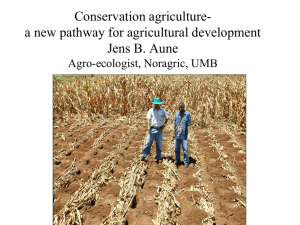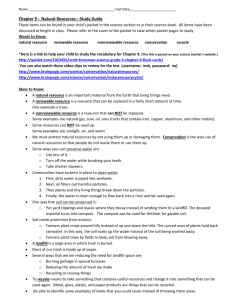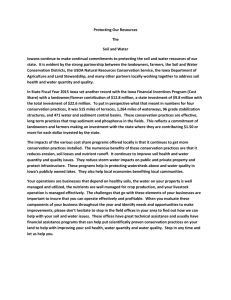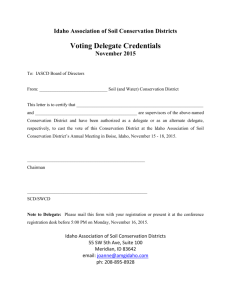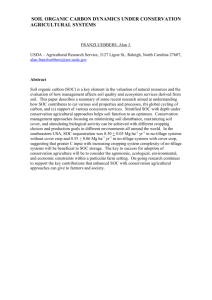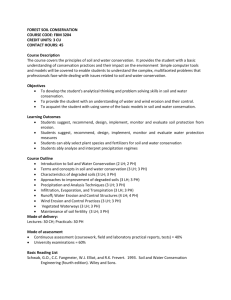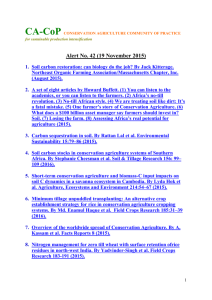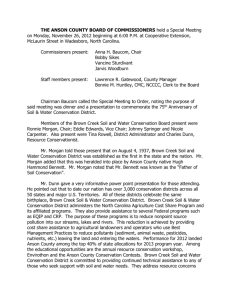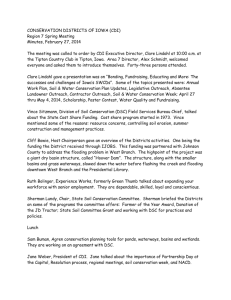A sustainable practice for Africa`s agriculture.
advertisement
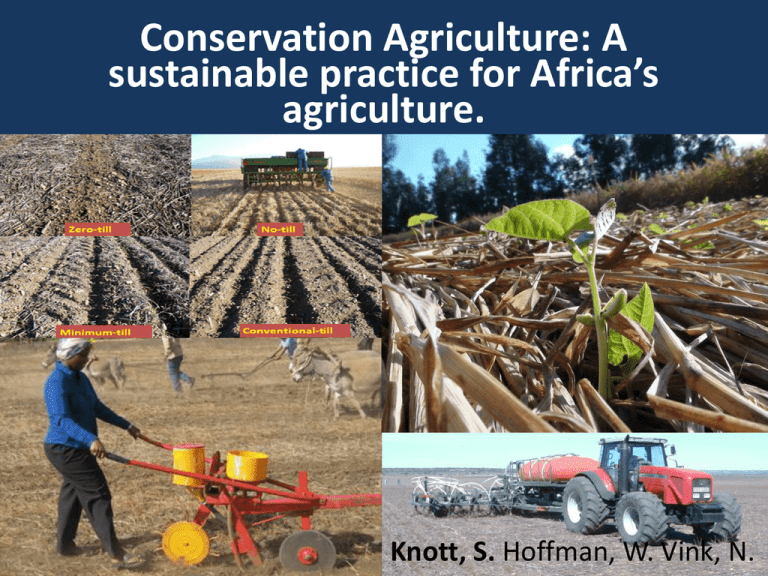
Conservation Agriculture: A sustainable practice for Africa’s agriculture. Knott, S. Hoffman, W. Vink, N. What is Conservation Agriculture • Conservation agriculture is not a single specific technology, rather it is a concept developed to encompass a number of technologies directed to improved land husbandry in a sustainable manner • Conservation Agriculture: ‘…an approach to managing agro-ecosystems for improved and sustained productivity, increased profits and food security while preserving and enhancing the resource base and the environment. CA is characterised by three linked principles, namely: • Continuous minimum mechanical soil disturbance. • Permanent organic soil cover. • Diversification of cover crop species grown in sequence and/or Key Drivers • • • • Declining world commodity margins Ground water pollution and soil degradation Herbicides Reduced input costs Benefits of CA • • • • • • • Reduced erosion and environmental degradation Improved soil structure and biology Improved soil moisture retention Higher soil Carbon levels Increased yields Reduced input costs (low external input) Reduced CO2 emissions (reduced use of fossil fuels) • Long term sustainability both environmental and economic Challenges of CA • • • • • Changing the Farmers Mind Set Farming – a high risk business Path dependence Differing Soil and Climatic Conditions Lack of Long term support for farmers Progression on CA Area (ha) under CA by continent, as percentage of total 117 million hectares worldwide North America, 43 090 000, 34% Australia & New Zealand, 17 162 000, 13% South America, 55 464 100, 43% Asia, 4 742 200, 4% Europe, 6 451 900, 5% Source: FAO Aquastat, 2014 Africa, 993 740, 1% In 1973/74 CA was used on 2.8million ha worldwide, growing to about 45 million ha in 1999 (Derpsch, 2001), 72 million ha 2003 (Benites, et al., 2003) and to 117 million ha by 2010 (FAO 2010) USA and Canada • • • • • • 1930’s Mid West, ‘Great Dust Bowl” Adoption slow due to weed infestations 1960’s development of herbicides, Atrazine Over supply of local market post Wars Mechanisation and economies of size Federal Government conservation Policies Australasia Australia, 17000 • 1970’s concerns of wind and water erosion • 1970’s and 80’s, increased government legislation with emphasis on custodianship of the land • 80% No-till adoption in the majority of regions by 2013 • main drivers for Australia; reduced fuel and labour costs at seeding, soil conservation, and soil moisture management • Government policy; rebate on the 15% tax paid on agricultural equipment specific to CA New Zealand, 162 Russian Federation Europe Slovakia Switzerland Spain Ukraine UK Finland France IrelandGermany Portugal Italy Hungary • European administrations are still not fully convinced that the concept of CA is the most promising one to meet the requirements of an environmentally friendly farming • Over supply post World Wars 1960’s • Common Agricultural Policy (CAP) promote conservation and environmental Stewardship Netherland Moldova s Asia DRP Korea, 23 China, 3100 Kazakhsta n, 1600 Lebanon, 1.2 • 1970’s Punjab University began trials on no-till for timely rice sowing • Development of site specific implements • Positive government policies in India, China, and Kazakhstan • Good extensive services and traveling seminars • Adoption is still lagging due to rice culture of ploughing Syria, 18 Conclusions • The challenge of feeding a growing world population from limited resources can only be met by the efficient use of the natural resources • The reality of all new technology is that it is adopted when it holds economic value and is socially acceptable, seldom when it is solely environmentally friendly • Conservation Agriculture provides the most holistic approach to a sustainable management system of agricultural land • The difficulty in adoption lies in the mind-set of the farmer, a lack of knowledge of how best to adopt the concept, availability of adequate machinery and herbicides, and the potential short-term loss of income and lag time of results

